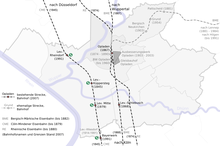New Bahnstadt Opladen
The Neue Bahnstadt Opladen (own spelling: neue bahnstadt opladen ) is a joint project of the city of Leverkusen and Deutsche Bahn AG for the reuse of former railway areas in the Opladen district as part of the Regionale 2010 . The project, in which an area of 72 hectares is to be redesigned, claims to show examples of strategies and approaches for reactivating unused railway and fallow land. The project is represented by the project company neue bahn stadt: opladen GmbH .
prehistory
See also:
Since the Bergisch-Märkische Eisenbahn-Gesellschaft opened the Opladen station in 1867, the places Opladen and Quettingen (both now part of the city of Leverkusen) have been separated by railway systems. In 1874 the Rhenish Railway Company added the Mülheim - Troisdorf line running parallel within Opladen with its own station. Further facilities such as a marshalling yard and a depot followed. Both lines were taken over by the Prussian State Railways in the 1880s. In 1903, east of the railway lines, also between Opladen and Quettingen, the main railway workshop in Opladen (later Opladen repair shop ) was opened, and later the neighboring track construction yard. Up to 2003, between 1,000 and 4,000 workers were employed in the repair shop.
While the railway became Opladen's most important employer for more than 100 years, its importance has steadily decreased since the 1950s. The Mülheim - Troisdorf route built by the Rheinische Bahngesellschaft was only used for freight traffic; the depot was gradually closed between 1960 and 1969, the marshalling yard and the track construction yard were shut down in the 1990s. As early as 2000, an urban perspective workshop was carried out at which the first planning goals for the urban development of the railway site were discussed, at that time still taking into account the continued operation of the repair shop. At the end of 2003, the repair shop was finally closed by Deutsche Bahn AG, despite violent protests from the workforce, so that its area was also included in the new planning.
Urban situation
The urban development situation is currently (2008) characterized by the fact that former and remaining railway facilities separate the districts of Opladen and Quettingen on the one hand, and the remaining freight train route separating Opladen station from Opladen city center and the neighboring bus station on the other. If this separation was justified at the time by the importance of the railways as a means of transport and employer, large parts of the former railroad areas are now unused and are available for improving the urban infrastructure and further development of the Opladen district. Traffic management for through traffic in the Opladen district has been complicated since the establishment of a pedestrian zone in the 1970s. Most of the buildings in the former repair shop have no future use in sight. Efforts to use the site by competitors of Deutsche Bahn AG did not lead to any result.
Planning
The aim of the planning is to revitalize the Opladen city center and to relocate the residential population, businesses and public institutions. The planning of the new Bahnstadt takes place in two stages:
Planning area east
This part of the area essentially comprises the 44 hectare site of the former repair shop as well as the fallow area of the former shunting tracks. In 2006 an architects 'competition to redesign the site was held, in which seven architects' offices took part. A jury made up of representatives from the city, Deutsche Bahn AG and the Regionale 2010 finally decided in favor of the current draft. This calls for the demolition of most of the buildings and all of the tracks of the former repair shop and the construction of new streets as well as residential and commercial areas, interrupted by generous “green axes”. Some smaller buildings are to be retained; the former water tower of the plant is to serve as a museum in the future. On May 10th, the city council of Leverkusen decided to sell the listed water tower to KG Altstadtfunken Opladen vun 1902 eV . The KG Altstadtfunken have since renovated the tower in consultation with the monument protection authority. The tower was completely scaffolded, cleaned and grouted. In addition to the water tower, a new building was added as a cube with a floor area of approx. 100 m². In addition to being used as a clubhouse and as a location for civil weddings, the tower is also rented out for celebrations, conferences and vernissages. On November 11, 2012, the old water tower was inaugurated as a radio tower by KG Altstadtfunken. Thanks to the financial support of the North Rhine-Westphalia Foundation, the German Monument Protection Foundation and the State of North Rhine-Westphalia, all planned tower renovation work could be carried out in coordination with the Lower Monument Authority.
West planning area
For this part of the site, the first ideas for the redesign have been made, but these have not yet been completed. The demolition of the previous station building is intended to create the possibility of relocating the freight train route directly next to the passenger train route. As a result, the city center can be expanded to include new residential and commercial areas on the area that will be vacated and the separation of the city center and the bus station from the train station can be lifted. While the platforms are to be retained and connected to the city center and Lützenkirchener Straße by a new bridge at the northern head of the station instead of the current underpass, it is still unclear whether a new station building will be built. Traffic management in the city center is to be relieved with the help of a new thoroughfare (“Neue Bahnallee”). The city center is also to be connected to the eastern part of the Bahnstadt with three bridges.
The city council of Leverkusen decided on May 13, 2013 to assume a share of the costs of 7 million euros for a relocation of the freight tracks to the east parallel to the passenger train route agreed with DB AG . The new route was put into operation in December 2016 after the Opladen station was demolished.
realization
As the first component of the large-scale project, two pedestrian and bicycle bridges were implemented. The design is based on a Europe-wide competition that the Knippers Helbig - Knight Architects consortium won in spring 2009. The campus bridge was opened as the first bridge in 2013, the station bridge followed in December 2015. The station building, built in 1969, was demolished in summer 2015 to make room for the planned relocation of the freight track.
Financial framework
The Bahnstadt project should cost a total of around 120 million euros, which includes 58 million euros in grants from the state of North Rhine-Westphalia and 22 million euros from planned property sales. The first grants of almost 2.7 million euros have already been awarded. On August 25, 2008, the Leverkusen city council approved important contracts for the realization of the Bahnstadt.
criticism
The financial feasibility of the major project is often questioned. It is not yet certain whether the targeted income can be achieved by selling land in the planned amount. Politicians also fear incalculable financial risks if the already bankrupt city of Leverkusen should, as planned, assume liability for possible, previously unknown contaminated sites on the railway site. These contaminated sites include old explosive ordnance that probably remained in the ground when the railway repair shop was bombed in World War II . Other such finds are already included in the schedule.
See also
Web links
Individual evidence
- ↑ Documentation of the architecture competition at www.regionale2010.de
- ↑ a b Leverkusener Anzeiger March 3, 2008 ( page no longer available , search in web archives ) Info: The link was automatically marked as defective. Please check the link according to the instructions and then remove this notice.
- ↑ Perspektivenwerkstatt leaves enough space for development
- ↑ "Say yes" - that works now also in the Funkenturm , Gabi Knops-Feiler, Rheinische Post, October 27, 2015
- ↑ "Funkenturm inaugurated" Leverkusener Anzeiger of November 12, 2012
- ↑ Rheinische Post from August 16, 2008 ( page no longer available , search in web archives ) Info: The link was automatically marked as defective. Please check the link according to the instructions and then remove this notice.
- ↑ Freight track in operation for the 2016 timetable change
- ↑ "Historical milestone for Leverkusen" - Campus bridge over the railway tracks officially opened
- ^ Opladen station: station bridge opened. In: Leverkusen.com. December 22, 2015, accessed September 19, 2016 .
- ↑ Local information on the demolition of the station
- ↑ Press release of the Cologne District Government ( page no longer available , search in web archives ) Info: The link was automatically marked as defective. Please check the link according to the instructions and then remove this notice.
- ↑ Rheinische Post from August 26, 2008 ( page no longer available , search in web archives ) Info: The link was automatically marked as defective. Please check the link according to the instructions and then remove this notice.
- ↑ Rheinische Post from August 16, 2008 on contaminated sites ( page no longer available , search in web archives ) Info: The link was automatically marked as defective. Please check the link according to the instructions and then remove this notice.
- ↑ 1800 bombs on Opladen , Ulrich Schütz, Rheinische Post, March 17, 2008
- ↑ More bomb finds in Opladen very likely , Miriam Betancourt and Hartmut Zitzen, Leverkusener Anzeiger, October 23, 2015






